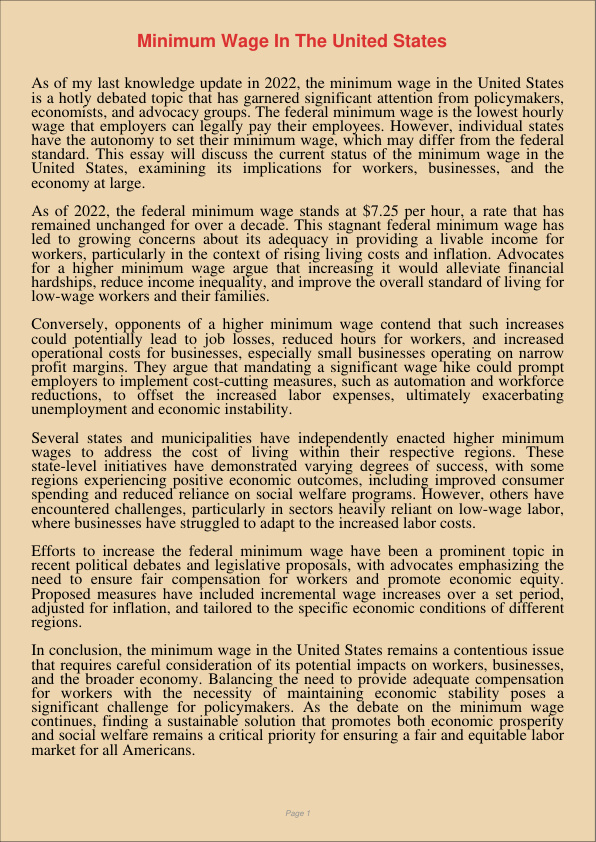Minimum Wage In The United States
Jan 12, 2024
united states
minimum wage
Business
Management

As of my last knowledge update in 2022, the minimum wage in the United States is a hotly debated topic that has garnered significant attention from policymakers, economists, and advocacy groups. The federal minimum wage is the lowest hourly wage that employers can legally pay their employees. However, individual states have the autonomy to set their minimum wage, which may differ from the federal standard. This essay will discuss the current status of the minimum wage in the United States, examining its implications for workers, businesses, and the economy at large.
As of 2022, the federal minimum wage stands at $7.25 per hour, a rate that has remained unchanged for over a decade. This stagnant federal minimum wage has led to growing concerns about its adequacy in providing a livable income for workers, particularly in the context of rising living costs and inflation. Advocates for a higher minimum wage argue that increasing it would alleviate financial hardships, reduce income inequality, and improve the overall standard of living for low-wage workers and their families.
Conversely, opponents of a higher minimum wage contend that such increases could potentially lead to job losses, reduced hours for workers, and increased operational costs for businesses, especially small businesses operating on narrow profit margins. They argue that mandating a significant wage hike could prompt employers to implement cost-cutting measures, such as automation and workforce reductions, to offset the increased labor expenses, ultimately exacerbating unemployment and economic instability.
Several states and municipalities have independently enacted higher minimum wages to address the cost of living within their respective regions. These state-level initiatives have demonstrated varying degrees of success, with some regions experiencing positive economic outcomes, including improved consumer spending and reduced reliance on social welfare programs. However, others have encountered challenges, particularly in sectors heavily reliant on low-wage labor, where businesses have struggled to adapt to the increased labor costs.
Efforts to increase the federal minimum wage have been a prominent topic in recent political debates and legislative proposals, with advocates emphasizing the need to ensure fair compensation for workers and promote economic equity. Proposed measures have included incremental wage increases over a set period, adjusted for inflation, and tailored to the specific economic conditions of different regions.
In conclusion, the minimum wage in the United States remains a contentious issue that requires careful consideration of its potential impacts on workers, businesses, and the broader economy. Balancing the need to provide adequate compensation for workers with the necessity of maintaining economic stability poses a significant challenge for policymakers. As the debate on the minimum wage continues, finding a sustainable solution that promotes both economic prosperity and social welfare remains a critical priority for ensuring a fair and equitable labor market for all Americans.